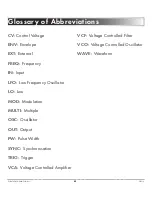
Studio Electronics Boomstar Manual
49
Panels
by the sustain setting; after the key has been released, the sound parameter
rises from sustain amplitude back to maximum amplitude: tricky and nice.
Switching
LOOP
on causes the attack and decay values to repeat or loop,
transforming Envelope 1 into a quasi LFO, but with far more swag.
The
DECAY
knob sets the decay time. The decay time determines the duration
of the second segment of the envelope, i.e., the fall from the attack peak to
the sustain level. While repeatedly depressing a key and incrementing the
value from “0 - 10” you will at first hear the brightness drop sharply after
the initial attack; the drop will become more gradual as the decay time
lengthens.
The
SUSTAIN
knob sets the sustain level. The sustain level determines the
filter frequency at which the envelope “levels off” after the initial rise and
fall. The frequency of the sustain level can be as high as the initial peak, in
which case there is no decay after the initial rise, or it can be as low as the
frequency at which the envelope contour began.
The
RELEASE
knob sets the release time and is the fourth and final stage
of the envelope contour. Finally, after the initial rise and fall of the attack
and decay times to the sustain level, the release time takes effect after the
sustain level segment, when the played key or note is lifted. The frequency
at which the sustain level is set, falls to the initial filter cutoff frequency level
at the rate set by the release time.
4.2.6 ENV 2 - Envelope 2
A
word about the Amplifier Envelope:
The volume of the audio signal,
which passes through the VCA envelope, is contoured by the envelope
controls. Each time a key is pressed, the envelope or “contour” generator
attached to the amplifier is actuated, and sends a control signal to the
amplifier. Like the filter envelope control signal, the VCA envelope control
















































